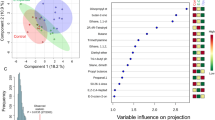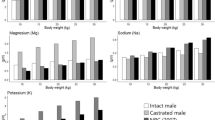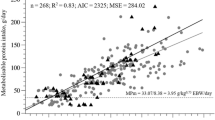Abstract
CLOVER infertility disease in sheep is attributed to the high concentrations of oestrogenic substances found in certain legumes such as subterranean clover, variety Yarloop1. Reduction in flock fertility can be as high as 75% with additional losses of lambing ewes due to dystocia2,3. Where large areas of these clovers are grown, as in western and southern Australia, the economic loss is considerable. Significant progress has been made in selecting clover varieties which have a low oestrogen content4 but replacement of established oestrogenic species has had limited success and the cost of renovation is often prohibitively high. We wish to report some observations which suggest that it may be possible to select and breed animals likely to be resistant to clover infertility disease using existing flocks classified on the basis of their haemoglobin (Hb) type.
This is a preview of subscription content, access via your institution
Access options
Subscribe to this journal
Receive 51 print issues and online access
$199.00 per year
only $3.90 per issue
Buy this article
- Purchase on Springer Link
- Instant access to full article PDF
Prices may be subject to local taxes which are calculated during checkout
Similar content being viewed by others
References
Moule, G. R., Braden, A. W. H., and Lamond, D. R., Anim. Breed. Abst., 31, 139 (1963).
Bennetts, H. W., Underwood, E. J., and Shier, F. L., Austral. Vet. J., 22, 2 (1946).
Maxwell, J. A. L., Austral. Vet. J., 46, 533 (1970).
Gladstones, J. S., Austral. J. Agric. Res., 18, 713 (1967).
Evans, J. V., King, J. W. B., Cohen, B. L., Harris, H., and Warren, F. L., Nature, 178, 849 (1956).
Evans, J. V., and Turner, H. N., Nature, 207, 1396 (1965).
Obst, J. M., thesis, Univ. New England, Armidale, Australia (1968).
Obst, J. M., and Evans, J. V., Proc. Austral. Soc. Anim. Prod., 8, 149 (1970).
Beck, A. B., Austral. J. Agric. Res., 15, 223 (1964).
Braden, A. W. H., Hart, N. K., and Lamberton, J. A., Austral. J. Agric. Res., 18, 335 (1967).
Shutt, D. A., and Braden, A. W. H., Austral. J. Agric. Res., 19, 545 (1968).
Dawson, T. J., and Evans, J. V., Amer. J. Physiol., 209, 593 (1965).
Author information
Authors and Affiliations
Rights and permissions
About this article
Cite this article
OBST, J., SEAMARK, R. & MCGOWAN, C. Haemoglobin Type and Fertility of Merino Ewes grazing Oestrogenic (Yarloop Clover) Pastures. Nature 232, 497–498 (1971). https://doi.org/10.1038/232497a0
Received:
Revised:
Published:
Issue Date:
DOI: https://doi.org/10.1038/232497a0
This article is cited by
Comments
By submitting a comment you agree to abide by our Terms and Community Guidelines. If you find something abusive or that does not comply with our terms or guidelines please flag it as inappropriate.



